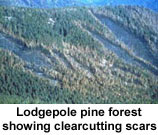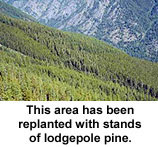National
Forests in Idaho- Forestry
Science
 The science of
logging - the cutting and hauling of logs - has grown with the rest of Idaho.
Up-to-date power machinery has taken
the place of the ax and two-man whipsaw for cutting down trees. One man with a
small chain saw can do the work of several old-time lumber jacks. Logs are still
being floated down Lake Coeur d'Alene to the mills, and trucks and trains still
haul logs, which are loaded with cranes
and other equipment. However, the exciting days of log drives down the Clearwater
River from the mountains to Lewiston are only a memory. Dams have made that impossible.
Today helicopters carry logs from steep hillsides and other places where there
are no roads
The science of
logging - the cutting and hauling of logs - has grown with the rest of Idaho.
Up-to-date power machinery has taken
the place of the ax and two-man whipsaw for cutting down trees. One man with a
small chain saw can do the work of several old-time lumber jacks. Logs are still
being floated down Lake Coeur d'Alene to the mills, and trucks and trains still
haul logs, which are loaded with cranes
and other equipment. However, the exciting days of log drives down the Clearwater
River from the mountains to Lewiston are only a memory. Dams have made that impossible.
Today helicopters carry logs from steep hillsides and other places where there
are no roads
In the early
days lumber companies cut large areas of timber without thinking of the damage
to the land. All the trees in an area were cut and a large amount of the wood
was lost because it was not the right size or type of wood.
 In
the 1920s and 1930s people began to understand that by cutting only mature trees,
the forests could be saved for the future, and the timber companies could continue
to make money. The lumber companies of today manage the forests very carefully.
Some of the most beautiful and most successfully managed forests in Idaho are
those run by the timber companies.
In
the 1920s and 1930s people began to understand that by cutting only mature trees,
the forests could be saved for the future, and the timber companies could continue
to make money. The lumber companies of today manage the forests very carefully.
Some of the most beautiful and most successfully managed forests in Idaho are
those run by the timber companies.
The Forest
Service has the job of making sure the national forests are put to the best
use for all Americans, present and future. The Forest Service sells trees to
lumber companies as they are needed, and makes sure the companies use good forest
management. One kind of good management is called selective cutting. Only
the large trees, or dead trees are cut. The loggers try to work carefully so
they won't damage very many of the younger trees. Young trees are then planted
to take the place of those cut. Planting young trees in the forest is called
reforestation.
When the young
trees grow large, the Forest Service will allow them to be cut, and more young
ones will be planted to take their place. In this way, trees are harvested like
a crop instead of being mined from the ground. This keeps the forests growing
forever, and America will have both trees and lumber for as long as the forests
keep growing.
Additional changes are being
made in terms of road construction, trail building and the like. Such activities
have slowed considerably and are conducted in a much more ecologically sound manner
today than in the past.
Written
and compiled by Jacqueline Harvey 1999.
 In
the 1920s and 1930s people began to understand that by cutting only mature trees,
the forests could be saved for the future, and the timber companies could continue
to make money. The lumber companies of today manage the forests very carefully.
Some of the most beautiful and most successfully managed forests in Idaho are
those run by the timber companies.
In
the 1920s and 1930s people began to understand that by cutting only mature trees,
the forests could be saved for the future, and the timber companies could continue
to make money. The lumber companies of today manage the forests very carefully.
Some of the most beautiful and most successfully managed forests in Idaho are
those run by the timber companies.  The science of
logging - the cutting and hauling of logs - has grown with the rest of Idaho.
Up-to-date power machinery has taken
the place of the ax and two-man whipsaw for cutting down trees. One man with a
small chain saw can do the work of several old-time lumber jacks. Logs are still
being floated down Lake Coeur d'Alene to the mills, and trucks and trains still
haul logs, which are loaded with cranes
and other equipment. However, the exciting days of log drives down the Clearwater
River from the mountains to Lewiston are only a memory. Dams have made that impossible.
Today helicopters carry logs from steep hillsides and other places where there
are no roads
The science of
logging - the cutting and hauling of logs - has grown with the rest of Idaho.
Up-to-date power machinery has taken
the place of the ax and two-man whipsaw for cutting down trees. One man with a
small chain saw can do the work of several old-time lumber jacks. Logs are still
being floated down Lake Coeur d'Alene to the mills, and trucks and trains still
haul logs, which are loaded with cranes
and other equipment. However, the exciting days of log drives down the Clearwater
River from the mountains to Lewiston are only a memory. Dams have made that impossible.
Today helicopters carry logs from steep hillsides and other places where there
are no roads